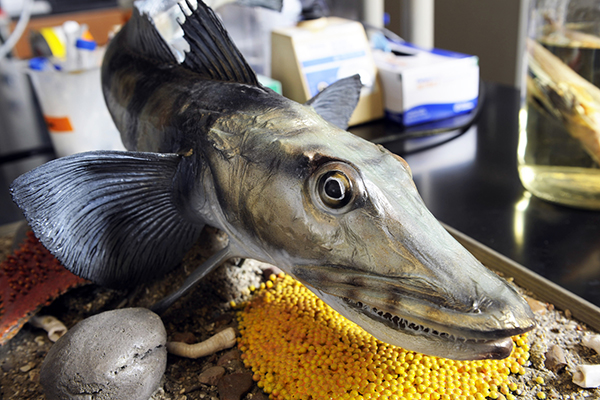Northeastern University professor H. William Detrich demonstrates that you can make a hybrid icefish

Science experiments don’t always run smoothly. Equipment breaks, the weather interferes, study subjects fail to cooperate. Researchers do the best they can to cope with these situations. Occasionally, the changes they make to deal with unforeseen circumstances lead to unexpected discoveries.
Such was the case for H. William Detrich, a Northeastern professor of marine and environmental sciences who recently demonstrated that sperm and eggs from icefish in two different genera can combine to create viable offspring.
“This is the first instance where two distinct genera, chionodraco and chaenocephalus, have been shown to be able to give rise to offspring that can develop and hatch,” Detrich says.
Producing viable hybrid offspring can be a valuable way to create new combinations of genes, which can lead to the development of new species. But Detrich and his colleagues didn’t set out to study hybrids.
The 16 species of icefish found in the waters around Antarctica share a variety of distinctive traits, including translucent blood that lacks the red blood cells and hemoglobin that every other vertebrate needs to survive. The researchers originally intended to study how warming waters predicted by climate models might affect the growth and development of icefish, given their unique biology.
Their experiment required eggs and sperm from blackfin icefish. But there was no male blackfin icefish ready to reproduce among the fish they caught.
“Faced with this, we said, ‘Okay, do we have a fertile male of any icefish species?’” Detrich says. “And that was the start of the experiment.”
Detrich and his colleagues combined the sperm from a male ocellated icefish with the eggs from the blackfin female, but they didn’t have high hopes that the embryo would develop. While some evidence suggests that certain species of icefish have hybridized with others in the past, Detrich says, those animals were closely related. The blackfin and ocellated icefish are not just separate species, they are also members of two separate genera.
So, when the egg cells began to divide, the researchers were shocked.
“I was very surprised initially, when we saw that one cell split into two, and two into four, four into eight,” Detrich says. “One of my colleagues looked at the eight-cell embryo and said, ‘No, that’s not real.’ But they kept going, and after a while not-real became real.”

Detrich and his colleagues combined the sperm from a male ocellated icefish with the eggs from the blackfin female, but they didn’t have high hopes that the embryo would develop. Photo by Matthew Modoono/Northeastern University
Over the next four and a half months, the embryos continued to develop, forming eyes, fins, and sharp little teeth. And eventually, they hatched.
The larvae survived and grew for two weeks, until the researchers’ time in Antarctica ran out and they had to wrap up the experiment. Because the larvae didn’t reach sexual maturity (which takes about seven years), the researchers don’t know if they would have survived into adulthood or been able to reproduce, but genetic analysis of the larvae showed that they were true hybrids, with genes from both parents.
True hybridization is rare, because the parent species must have compatible chromosomes to create viable offspring together. It is even rarer outside of the lab, as animals may mate at different times or have specific courtship rituals that interfere with their ability to recognize each other as viable partners.
By taking a chance on an unplanned experiment, Detrich and his colleagues have begun to explore the potential for icefish to hybridize and create new species. This knowledge could help researchers understand how a creature as bizarre as the icefish evolved and how well it may adapt in the future.
“It was serendipity,” Detrich says. “This was an opportunity that presented itself, and we seized it.”
For media inquiries, please contact Shannon Nargi at s.nargi@northeastern.edu or 617-373-5718.





